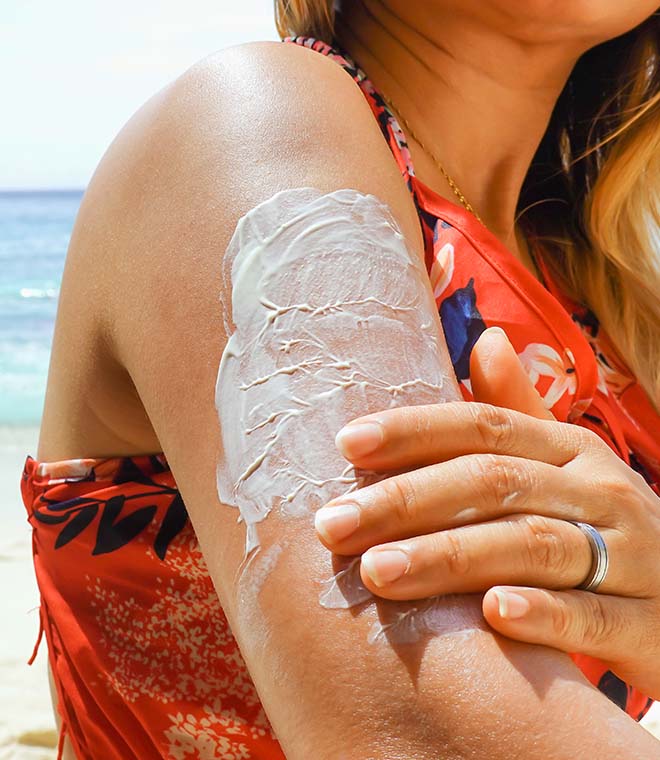Beauty
Comparing sunscreens: Exploring SPF options
By Jenilee Matz, MPH May 03, 2021 • 6 min.
Deciding which sunscreen is right for you starts with understanding your options.
Should you go for a water-resistant sunscreen, powdered sunscreen, facial sunscreen or a sunscreen and bug repellent combo? Here's what you really need to know to help you make a decision.
What makes the best sunscreen?
When it comes to choosing a sunscreen, make sure it:
- Has a sun protection factor or SPF of 30 or higher. What does SPF mean? It refers to the level of protection the sunscreen provides against the sun's harmful ultraviolet B (UVB) rays. An SPF 30 sunscreen blocks close to 97% of UVB rays, while an SPF 50 sunscreen filters out about 98% of UVB rays.
- Is labeled as broad-spectrum or states it protects against ultraviolet A (UVA) and UVB rays. UVB radiation can burn your skin, but UVA rays are dangerous, too. UVA rays can speed up skin aging. Too much exposure to either UVA or UVB rays can cause skin cancer. The safest sunscreen choice is one that filters both types of radiation and is used as directed.
- Is water-resistant. This means the sunscreen can still briefly work on wet or sweaty skin. Still, you should reapply sunscreen right after swimming, sweating or drying off. Know that no sunscreen is waterproof or sweatproof.
Can I still get a tan when I wear sunscreen?
No sunscreen can protect against 100% of the sun's harmful UV rays. So, it's still possible to get a sunburn or tan even if you use sunscreen appropriately and take other measures to avoid the sun, such as sitting in the shade. Know that getting a tan is dangerous, too. Tanned skin has been exposed to and damaged by UV radiation.
Is sunscreen safe for babies and children?
The best protection for infants younger than 6 months is to keep them out of direct sunlight. If your baby will be outside, protect their skin with shade and clothing. Babies 6 months and older can wear sunscreen. Sunscreen with zinc oxide or titanium oxide may be less irritating to your baby's skin.
Many parents find it easier to apply spray sunscreen rather than sunscreen lotions to squirmy children. If you use a spray sunscreen, spray it on your hands first and then use your fingers to apply it to your child's face. Never apply spray sunscreen directly to the face.
What's the difference between chemical sunscreen vs. physical sunscreen ingredients?
Many sunscreens contain both chemical and physical ingredients. Chemical sunscreens protect your skin by absorbing UV rays and converting them into heat energy. Examples of chemical sunscreen ingredients include oxybenzone and avobenzone. Physical or mineral sunscreens, on the other hand, protect you by reflecting UV rays before they reach your skin. Titanium dioxide and zinc oxide are physical sunscreen ingredients.
What else should I look for in a sunscreen?
When shopping for a sunscreen, consider the following:
- If certain ingredients used in sunscreen concern you, check out the Environmental Working Group’s Guide to Sunscreen for the sunscreen rating on your favorite product.
- Some people turn to organic sunscreen or biodegradable sunscreen because they want a more natural option. If you go this route, make sure you read labels closely and choose a sunscreen with an SPF of 30 or higher that’s broad spectrum and water-resistant.
- Do not use a sunscreen and bug repellent combination product. Sunscreen needs to be reapplied often whereas insect repellent does not. Instead, buy two different products and put them on separately.
How much sunscreen do I really need?
Wearing sunscreen when you'll be outside for longer than brief periods is a must, especially if you'll be out between the hours of 10 a.m. and 4 p.m. This is when the sun's harmful ultraviolet (UV) rays are at their peak. It's when you're most likely to get a sunburn, which increases your risk for skin cancer and premature skin aging. You should also use sunscreen on cloudy days, as UV rays can still reach your skin through clouds. Apply a generous amount of sunscreen before you head outdoors. Many adults need about 1 ounce, or the amount it takes to fill a shot glass, to cover all exposed areas of their bodies. It can take 15 minutes for your skin to absorb sunscreen. It's also important to reapply sunscreen at least every two hours, if you'll be outdoors all day.
Does sunscreen expire?
Most sunscreens are designed to be effective for up to three years, but it eventually expires. If the shelf-life of a product is shorter, the U.S. Food and Drug Administration (FDA) requires an expiration date on the label. Throw away any expired sunscreen products. If your sunscreen doesn't list an expiration date, write down the date you purchased it on the bottle and discard it within three years of that purchase date.
Clinically reviewed May 2021.
Sources:
1. https://medlineplus.gov/ency/article/003227.htm
4. https://www.aad.org/public/spot-skin-cancer/learn-about-skin-cancer/prevent/how-to-apply-sunscreen
5. https://www.health.harvard.edu/cancer/how-to-choose-and-use-sunscreen
6. https://www.ewg.org/sunscreen/all-sunscreens/#.Wudxg_krJD8
8. https://www.cancer.org/latest-news/choose-the-right-sunscreen.html
9. https://www.skincancer.org/prevention/sun-protection/sunscreen/choosing
10. https://www.skincancer.org/prevention/sun-protection/sunscreen/sun-protection-and-makeup
12. https://www.skincancer.org/skin-cancer-prevention/sun-protection/sunscreen/
13. https://www.piedmont.org/living-better/the-difference-between-physical-and-chemical-sunscreen



